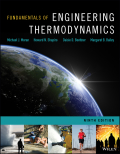
Fundamentals Of Engineering Thermodynamics
9th Edition
ISBN: 9781119391388
Author: MORAN, Michael J., SHAPIRO, Howard N., Boettner, Daisie D., Bailey, Margaret B.
Publisher: Wiley,
expand_more
expand_more
format_list_bulleted
Question
Chapter 1, Problem 1.33CU
To determine
Extensive properties are a function of time whereas intensive properties are a function of time and position both: the given statement is true or false.
Expert Solution & Answer
Want to see the full answer?
Check out a sample textbook solution
Students have asked these similar questions
(◉
Home - my.uah.edu
Homework#5
MasteringEngineering Mastering X +
8 https://session.engineering-mastering.pearson.com/myct/itemView?offset=next&assignmentProblemID=18992146
(read image)
(◉
Home - my.uah.edu
Homework#5
MasteringEngineering Mastering X +
8 https://session.engineering-mastering.pearson.com/myct/itemView?assignmentProblemID=18992147&offset=next
Chapter 1 Solutions
Fundamentals Of Engineering Thermodynamics
Ch. 1 - Prob. 1.2ECh. 1 - Prob. 1.3ECh. 1 - Prob. 1.4ECh. 1 - Prob. 1.5ECh. 1 - Prob. 1.6ECh. 1 - Prob. 1.7ECh. 1 - Prob. 1.8ECh. 1 - Prob. 1.9ECh. 1 - Prob. 1.10ECh. 1 - Prob. 1.11E
Ch. 1 - Prob. 1.12ECh. 1 - Prob. 1.13ECh. 1 - Prob. 1.14ECh. 1 - Prob. 1.1CUCh. 1 - Prob. 1.2CUCh. 1 - Prob. 1.3CUCh. 1 - Prob. 1.4CUCh. 1 - Prob. 1.5CUCh. 1 - Prob. 1.6CUCh. 1 - Prob. 1.7CUCh. 1 - Prob. 1.8CUCh. 1 - Prob. 1.9CUCh. 1 - Prob. 1.10CUCh. 1 - Prob. 1.11CUCh. 1 - Prob. 1.12CUCh. 1 - Prob. 1.13CUCh. 1 - Prob. 1.14CUCh. 1 - Prob. 1.15CUCh. 1 - Prob. 1.16CUCh. 1 - Prob. 1.17CUCh. 1 - Prob. 1.18CUCh. 1 - Prob. 1.19CUCh. 1 - Prob. 1.20CUCh. 1 - Prob. 1.21CUCh. 1 - Prob. 1.22CUCh. 1 - Prob. 1.23CUCh. 1 - Prob. 1.24CUCh. 1 - Prob. 1.25CUCh. 1 - Prob. 1.26CUCh. 1 - Prob. 1.27CUCh. 1 - Prob. 1.28CUCh. 1 - Prob. 1.29CUCh. 1 - Prob. 1.30CUCh. 1 - Prob. 1.31CUCh. 1 - Prob. 1.32CUCh. 1 - Prob. 1.33CUCh. 1 - Prob. 1.34CUCh. 1 - Prob. 1.35CUCh. 1 - Prob. 1.36CUCh. 1 - Prob. 1.37CUCh. 1 - Prob. 1.38CUCh. 1 - Prob. 1.39CUCh. 1 - Prob. 1.40CUCh. 1 - Prob. 1.41CUCh. 1 - Prob. 1.42CUCh. 1 - Prob. 1.43CUCh. 1 - Prob. 1.44CUCh. 1 - Prob. 1.45CUCh. 1 - Prob. 1.46CUCh. 1 - Prob. 1.47CUCh. 1 - Prob. 1.48CUCh. 1 - Prob. 1.49CUCh. 1 - Prob. 1.50CUCh. 1 - Prob. 1.51CUCh. 1 - Prob. 1.52CUCh. 1 - Prob. 1.53CUCh. 1 - Prob. 1.54CUCh. 1 - Prob. 1.55CUCh. 1 - Prob. 1.56CUCh. 1 - Prob. 1.57CUCh. 1 - Prob. 1.58CUCh. 1 - Prob. 1.4PCh. 1 - Prob. 1.5PCh. 1 - Prob. 1.6PCh. 1 - Prob. 1.7PCh. 1 - Prob. 1.8PCh. 1 - Prob. 1.9PCh. 1 - Prob. 1.10PCh. 1 - Prob. 1.11PCh. 1 - Prob. 1.12PCh. 1 - Prob. 1.13PCh. 1 - Prob. 1.14PCh. 1 - Prob. 1.16PCh. 1 - Prob. 1.17PCh. 1 - Prob. 1.18PCh. 1 - Prob. 1.19PCh. 1 - Prob. 1.20PCh. 1 - Prob. 1.21PCh. 1 - Prob. 1.22PCh. 1 - Prob. 1.23PCh. 1 - Prob. 1.24PCh. 1 - Prob. 1.25PCh. 1 - Prob. 1.26PCh. 1 - Prob. 1.27PCh. 1 - Prob. 1.28PCh. 1 - Prob. 1.29PCh. 1 - Prob. 1.30PCh. 1 - Prob. 1.31PCh. 1 - Prob. 1.32PCh. 1 - Prob. 1.33PCh. 1 - Prob. 1.34PCh. 1 - Prob. 1.35PCh. 1 - Prob. 1.36PCh. 1 - Prob. 1.37PCh. 1 - Prob. 1.38PCh. 1 - Prob. 1.39PCh. 1 - Prob. 1.40PCh. 1 - Prob. 1.41PCh. 1 - Prob. 1.42PCh. 1 - Prob. 1.43PCh. 1 - Prob. 1.44PCh. 1 - Prob. 1.45PCh. 1 - Prob. 1.46PCh. 1 - Prob. 1.47PCh. 1 - Prob. 1.48PCh. 1 - Prob. 1.49P
Knowledge Booster
Learn more about
Need a deep-dive on the concept behind this application? Look no further. Learn more about this topic, mechanical-engineering and related others by exploring similar questions and additional content below.Similar questions
- (◉ Home - my.uah.eduarrow_forward(read image)arrow_forward(◉ Home - my.uah.edu Homework#5 MasteringEngineering Mastering X + 8 https://session.engineering-mastering.pearson.com/myct/itemView?assignmentProblemID=18992148&offset=nextarrow_forward(◉ Home - my.uah.edu Homework#5 MasteringEngineering Mastering X + 8 https://session.engineering-mastering.pearson.com/myct/itemView?assignmentProblemID=18992144&offset=nextarrow_forwardCalculate the forces in members BC, BG & FG of the truss shown using the Method of Sections. For your answer, provide atruss diagram of the calculated member forces and indicate whether the member is in Tension (+) or Compression (-)arrow_forwardSelect the speed, feed and depth of the cut to turn wrought, low carbon steel (hardness of 200 BHN) on lathe with AISI tool material of HSS M2 or M3. (Hint: refer to Chapter 21 for recommended parameters).arrow_forwardarrow_back_iosSEE MORE QUESTIONSarrow_forward_iosRecommended textbooks for you
 Automotive Technology: A Systems Approach (MindTa...Mechanical EngineeringISBN:9781133612315Author:Jack Erjavec, Rob ThompsonPublisher:Cengage Learning
Automotive Technology: A Systems Approach (MindTa...Mechanical EngineeringISBN:9781133612315Author:Jack Erjavec, Rob ThompsonPublisher:Cengage Learning
 Automotive Technology: A Systems Approach (MindTa...Mechanical EngineeringISBN:9781133612315Author:Jack Erjavec, Rob ThompsonPublisher:Cengage Learning
Automotive Technology: A Systems Approach (MindTa...Mechanical EngineeringISBN:9781133612315Author:Jack Erjavec, Rob ThompsonPublisher:Cengage Learning
Lesson 2: Thermodynamic Properties; Author: The Thermo Sage;https://www.youtube.com/watch?v=qA-xwgliPAc;License: Standard Youtube License